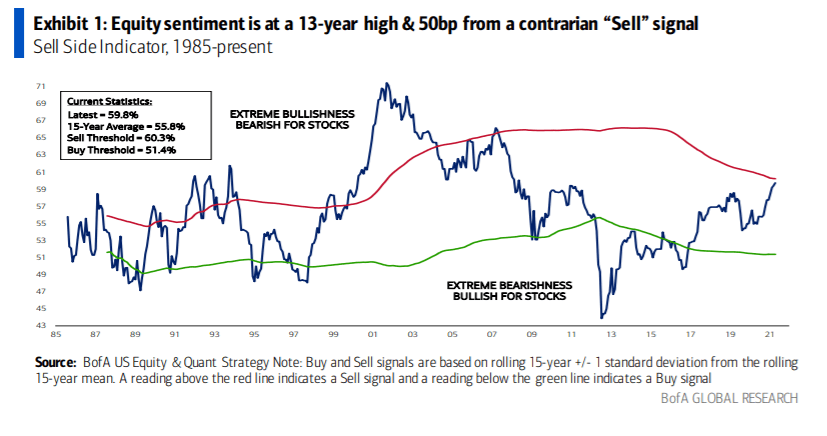BofA Securities' measure of Wall Street sell-side sentiment is pushing into euphoria territory, at the highest level since the FinancialCrisis.
The Sell Side Indicator, which tracks the recommended equity allocation by sell-side strategists rose to 59.8% from 59.4%, the highest it's been in 13 years.
It has risen four month in the row and is just 50 basis points away from a contrarian Sell signal (60.3%). That's the closest it's been to a sell signal since May 2007, with the S&P 500(SP500)(NYSEARCA:SPY)seeing a drop of 7% over the next 12 months.
"Increasingly euphoric sentiment is a driver of our more cautious outlook as we believe that vaccine deployment, economic reopening, stimulus, etc. are largely priced in," BofA strategists led by Savita Subramaniam, wrote in a note. "We have not seen a 5% pullback in six months (they have occurred on average 3x per year) nor have we experienced a 10% correction in 14 months (a once per year phenomenon, historically)."
"Sentiment continues to climb as market gains continue: the year-over-year rise in our Sell Side Indicator is in the 85th percentile of our data history and above 1 std. deviation," they add. "Since March 2020, equity allocations have risen >3.5x faster than they typically do following bear markets."
"Lofty valuations, juxtaposed against the potential for bad inflation, rising rates, and higher taxes on corporates and consumers. But we are bullish on economic/profits/capex growth, driving our preference for cyclical stocks."
While at a 13-year high, the indicator is still technically in Neutral territory, indicating positive returns over the next 12 months.
But it is forecasting returns of just 6%, well below the average 12-month forecast of 14% since the financial crisis.
Other sentiment measures are also at historically high levels.
The Citi Panic/Euphoria sentiment measure ticked up to 1.22 from an upwardly revised 1.17 the week before, near the peaks of positive sentiment seen during the dot-com bubble (euphoria is anything above 0.38).
But Cannacord analyst Tony Dwyer says thatthe type of questions asked at Federal Reserve Chairman Jay Powell's press conference last week may indicate an inflection point on sentiment.

精彩评论